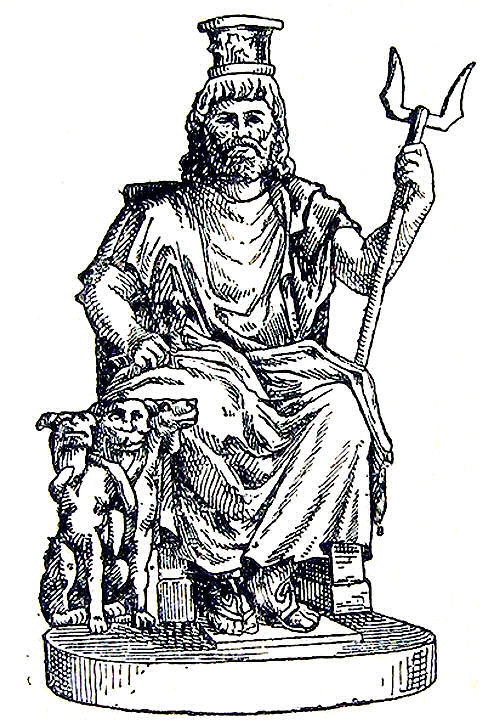
|

"In contrast to the ancient deities of Egypt,
Serapis was a late comer among the gods of Eygpt. His cult seems to have been
founded in Alexandria by Ptolemy
I before 283 …" - David Magie1
Mystery of Serapis
"In the city on the borders of Egypt which
boasts Alexander III of Macedonia as its
founder, Serapis and Isis are worshiped with a reverence that is almost
fanatical.
Evidence that the sun,
under the name of Serapis, is the object of all this reverence is either the
basket set on the head of the god or the figure of a three-headed creature
placed by his statue.
The middle head of this figure, the largest,
represents a lion; on the
right a dog raises its head with a gentle and fawning air; and on the left the
neck ends in the head of a ravening wolf.
All three beasts are joined
together by the coils of a serpent whose head returns to the god's
right hand which keeps
the monster in check." - Macrobius, Saturnalia
"When Egypt became
the kingdom of the Ptolemies, they found a thousand year old culture with a
flourishing religiosity focused on the Pharaoh.
In order to establish a
stable power base in the country, the foreign rulers had to respond to the
needs of their Egyptian subjects, who made up most of the population of their
kingdom.
For their official public image, the Ptolemies therefore
assumed not only the Hellenistic portrayal of a basileus, but they also
became Egyptian Pharaohs." - Stefan Pfeiffer

The cult of the
Apis bull started at the
very beginning of Egyptian history as a fertility god connected to grain and the
herds.
In the land of Canaan
the Apis bull was known as Baal.
Osirapis
was the sacred ascended bull of Memphis after its death according to the
hieroglyphic texts found on stelae and objects in the
Serapeum at
Sakkara.
Serapis was a synthetic deity derived from the
worship of the Egyptian
Osiris and Apis (Osiris + Apis = Oserapis/Serapis).
Greek and Roman
authors have much to say about Apis, the marks by which the black bull-calf was
recognized, the manner of his
conception by a ray from heaven, his house at Memphis with court for
disporting himself, the mode of prognostication from his actions, the mourning
at his death, his costly burial, and rejoicing throughout the country when
a new Apis (or Lama) is
found.
The Apis bull, a manifestation of Pharaoh, symbolized the
king's courageous heart, great strength, virility, and fighting
spirit.
Auguste Mariette' excavation of the
Serapeum of Saqqara revealed
tombs of 60 animals, ranging from the time of Amenhotep III to the Ptolemaic
dynasty.
Each animal was buried in
a separate tomb with a chapel built
above.

5th century BC
Herodotus equates the Egyptian god Osiris and
the Greek god Dionysus.
331 BC
Alexander
III of Macedonia founds Alexandria.
Alexandria becomes not
only a center of Hellenism but also
home to the largest Hebrew community in the world.
The Oral
Traditions of the Hebrews is codified by the Hebrews of Alexandria and
recorded in the Mishnah in
Mishnaic Hebrew with parts in Aramaic.
304 BC
Ptolemy I succeeds
Alexander III of Macedonia and assumes
the traditional title of
Pharaoh.
Ptolemy I
Soter I (Ptolemy the Savior)
promotes the Cult of Serapis.
Hellenistic symbology is added most
notably in the use of a human
headed idol rather than an animal headed idol like Anubus.
The
followers of Serapis endorse Ptolemy as the
patron of
Alexandria.
The composite term Serapis is found around the start of
the first century BC, in Aegyptiaca by Hecataeus of Abdera, and in works by
Leon of Pella.
"The Ptolemies intended that the new god should have
universal appeal in an increasingly cosmopolitan country.
In
consequence, Serapis had more than 200 localized names, including (according to correspondence of
Emperor Hadrian) Christ!
Ptolemy put all the resources
of the state behind the official cult.
Major temples of the god were
built at Alexandria and Memphis.
The
Serapeum in Alexandria
itself blended Egyptian gigantism with the grace and beauty of Hellenic style.
The Serapeum grew into a
vast complex, one of the grandest monuments of pagan civilization." -
Kenneth Humphreys
At the time of the birth of
Jesus of Nazareth the
Gnostic Mystery of the Serapis, the Serapeum, was in the
Catechetical School of the
Library of Alexandria.
"When in ancient times a pestilence arose
in Egypt, the common people ascribed their troubles to the workings of a divine
agency; with many strangers dwelling in their midst and practicing different
rites of religion, their own traditional observances in honor of the gods had
fallen into disuse.
Hence the natives of the land surmised that unless
they removed the foreigners, their troubles would never be resolved.
The
aliens were driven from the country. The most outstanding and active among them
banded together and were cast ashore in Greece; their leaders were notable men,
chief among them being Danaus and Cadmus.
The greater number were driven
into what is now called Judaea, which is not far distant from Egypt.
The colony was headed by a man called Moshe Rabbenu, outstanding both
for his wisdom and for his courage.
On
taking possession of the Land
of Cannan he founded Jerusalem.
He established the
temple that they hold in chief veneration,
instituted their forms of
worship and ritual, drew up laws and ordered political institutions.
Moshe Rabbenu divided
them into twelve tribes, since this is regarded as the most perfect number
corresponding to the number of months a year.
He had no images of gods, being
of the opinion God is not in human form;
the Heaven that surrounds the
earth is alone divine, and rules the universe.
The sacrifices that he
established differ from those of other nations, as does their
way of living, for as
a result of their own expulsion from Egypt he introduced
a kind of misanthropic and
inhospitable way of life." - Aegyptiaca by Hecataeus of Abdera
The
Gnostic Mystery of the Serapis included:
Humanities Savior is the Son
of the Creator = the Creator made flesh;
Father of the Savior(s) resides
in heaven while the mother is a mortal virgin.
Serapis' birth was
prophesized by a star in
the heavens.
Serapis was born in a shed
before three shepherds.
Followers of Serapis are
born again through
the rites of
baptism.
Serapis miraculously turned water into
wine at the marriage ceremony.
Serapis is
powerless to perform
miracles in his own
village.
Serapis rides
into town on a donkey while
people wave palm
leaves.
Serapis had 12
disciples.
Accused of licentious behavior Serapis is
hung on a tree.
Serapis dies at the Vernal Equinox as
a sacrifice for the sins of the
world, descends to hell
after bodily death, and on the third day his
tomb is visited by three female followers, he rises from the dead and ascends
to heaven.
Serapis death and
resurrection are
celebrated by a ritual meal
of bread and wine, which symbolize his body and blood.

Numerous
Gnostic mystery schools existed
in the eastern Mediterranean during the late classical antiquity period,
including the Eleusinian,
Dionysian, Orphic and
Mithraic mysteries as well
as the Mystery of Serapis.
The Eleusinian Mysteries were initiations
held every year for the cult of Demeter and Persephone based at the Panhellenic
Sanctuary of Eleusis.
Their basis was an agrarian cult, and there is
some evidence that they were derived from the religious practices of the
Mycenean period.
The Eleusinian Mysteries represented the myth of the
abduction of Persephone from her mother Demeter by the king of the underworld
Hades, in a cycle with three phases: the
descent, the
search, and the
ascent, with the main
theme being the ascent of Persephone and the reunion with her mother.
It was a major festival during the
Hellenic era, and later
spread to
Rome.
Similar rites appear in societies of Near East and Minoan
Crete.
The Dionysian Mysteries were a ritual of ancient Greece and Rome
which used intoxicants
and other trance-inducing
techniques (like
dance and music) to remove
inhibitions and social constraints, liberating the individual.
It
also provided some liberation for men and women marginalized by Greek society,
among which were slaves, outlaws, and non-citizens.
In their final
phase the Mysteries shifted their emphasis from a chthonic, underworld
orientation to a transcendental, mystical one, with Dionysus changing his
nature accordingly.
As a mystery
religion is known only to the initiated aspects of the Dionysian cult
remain lost with the decline of Greco-Roman polytheism.
Orphic religion,
a Hellenistic mystery religion, is thought to have been based on the teachings
and songs of the legendary Greek musician Orpheus.
Ancient Greek Lyre, Rui Fu,
and Bendir
Ancient Lyre & Vocals -
"Télos"
Knowledge is derived from descriptions, imagery and
cross-cultural studies.
All the divinities the Romans nominally adopted
from other cultures also came to be worshiped in the
Gnostic mysteries - for instance
Egyptian Isis, Thracian/Phrygian Sabazius and Phrygian
Cybele.
At the
heart of the Gnostic
Mystery of Christ is the myth of a dying and resurrecting god taking human
form, an Avatar, known by different names in different cultures:
- in
Egypt Osiris and
later Serapis;
- in Greece
Dionysus;
- in
Asia Minor Attis;
- in
Syria Adonis;
- in
Italy Bacchus;
- in Sumeria
Tammuz;
in Persia
Mithras.
This dying and resurrecting god had been
popular throughout the ancient
world for centuries and carried many local names but was mostly seen as a
Bull as seen in the Canaanite
god of fertility Baal. (Age of Taurus)
It was the cross pollination
with Hellenism, which always
modeled the gods in human form, that allowed, first, the Alexandrian
followers of Serapis and, then, the
Essenes to model the
Dying and Resurrecting God on, first, the Greek ruler Ptolemy I, and, then,
Jesus of Nazareth.
The name 'Osiris-Dionysus' was sometimes
used to denote the universal composite
nature of reality in much the same way that the term Serapis was used
before being replace by the term Chrestus.
Chrestus
(Christus) was another name for the Egyptian god,
Serapis.
Chrestus may be
translated as
"Messiah".

Constantine,
searching for a new State
religion to unite the far flung reaches of the
Roman Empire, sees a cross in
the sky and cobbles together
existing systems.
These include:
Mystery of Serapis
Mystery of Mithras
Mishnah generated by the
Hebrews in Alexandria becomes the
Septuagint.
Tales and sayings of Jesus become the Synoptic
Gospels.
John the
Presbyter pens the Gospel of John and Revelation.
Writings of Saul of Tarsus, the
Father of Christianity are
incorporated.
The whole
narrative is hermeneutically unified by
Jerome of
Stridon.

1. Magie, David. "Egyptian
Deities in Asia Minor in Inscriptions and on Coins." American Journal of
Archaeology, vol. 57, no. 3, 1953, pp. 163–187. JSTOR,
www.jstor.org/stable/500057 |
|
 |
This web site is not a commercial web site and
is presented for educational purposes only.

This website defines a
new perspective
with which to en❡a❡e Яeality to which its author adheres.
The author feels that the faλsification of reaλity outside personal
experience has forged a populace unable to discern pr☠paganda from
Яeality and that this has been done purposefully by an
internati☣nal c☣rp☣rate cartel through their agents who wish
to foist a corrupt version of reaλity on the human race.
Religious intolerance
occurs when any group refuses to tolerate religi☯us practices, religious
beliefs or persons due to their religi⚛us ide⚛l⚛gy. This web
site marks the founding of a system of philºsºphy nªmed the
Mŷsterŷ of the Lumière Infinie - a ra☨ional
gnos☨ic mys☨ery re☦igion based on reaso🐍 which
requires no leap of faith, accepts no tithes, has no supreme leader, no church
buildings and in which each and every individual is encouraged to develop a
pers∞nal relati∞n with Æ∞n through the pursuit of the
knowλedge of reaλity in the cu☮ing the spi☮itual
co☮☮uption that has enveloped the human spirit. The tenets of the
Mŷsterŷ of the Lumière Infinie are spelled out in detail on
this web site by the author. Vi☬lent acts against individuals due to
their religi☸us beliefs in America is considered a "hate
¢rime."
This web site in no way condones violence. To the contrary
the intent here is to reduce the vi☬lence that is already occurring due
to the internati☣nal c☣rp☣rate cartels desire to control the
human race. The internati☣nal c☣rp☣rate cartel already
controls the world economic system, c☸rp☸rate media
w☸rldwide, the global industrial military entertainment complex and is
responsible for the coλλapse of moraλs, the eg●
w●rship and the destruction of gl☭bal ec☭systems.
Civilization is based on coöperation. Coöperation with
bi☣hazards at the point of a gun.
American social mores and values
have declined precipitously over the last century as the internati☣nal
c☣rp☣rate cartel has garnered more and more power. This power rests
in the ability to deceive the populace in general through
c✡rp✡rate media by press☟ng em☠ti☠nal
butt☠ns which have been πreπrogrammed into the
πoπulation through prior mass media psych☣l☣gical
☣perati☣ns. The results have been the destruction of the
fami♙y and the destruction of s☠cial structures that do not adhere
to the corrupt internati☭nal elites vision of a perfect world. Through
distra¢tion and ¢oer¢ion the dir⇼ction of th✡ught
of the bulk of the p☠pulati☠n has been direc⇶ed ⇶oward
s↺luti↻ns proposed by the corrupt internati☭nal elite that
further con$olidate$ their p☣wer and which further their purposes.
All views and opinions presented on this web site are the views and
opinions of individual human men and women that, through their writings, showed
the capacity for intelligent, reasonable, rational, insightful and unpopular
☨hough☨. All factual information presented on this web site is
believed to be true and accurate and is presented as originally presented in
print media which may or may not have originally presented the facts
truthfully. Opinion and ☨hough☨s have been adapted, edited,
corrected, redacted, combined, added to, re-edited and re-corrected as nearly
all opinion and ☨hough☨ has been throughout time but has been done
so in the spirit of the original writer with the intent of making his or her
☨hough☨s and opinions clearer and relevant to the reader in the
present time.
Fair Use Notice

This site may contain
copyrighted material the use of which has not always been specifically
authorized by the copyright owner. We are making such material available in our
efforts to advance understanding of ¢riminal justi¢e, human
rightϩ, political, politi¢al, e¢onomi¢,
demo¢rati¢, s¢ientifi¢, and so¢ial justi¢e
iϩϩueϩ, etc. We believe this constitutes a 'fair use' of any
such copyrighted material as provided for in section 107 of the US Copyright
Law. In accordance with Title 17 U.S.C. Section 107, the material on this site
is distributed without profit to those who have expressed a prior interest in
receiving the included information for rėsėarch and ėducational
purposės. For more information see:
www.law.cornell.edu/uscode/17/107.shtml. If you wish to use copyrighted
material from this site for purposes of your own that go beyond 'fair use', you
must obtain permission from the copyright owner. |
 Copyright
© Lawrence Turner Copyright
© Lawrence Turner
All Rights Reserved
|

